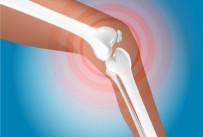What does physics have to do with knee pain?

What does physics have to do with knee pain?
Written by: Paul Kochoa, PT, DPT, OCS, CKTP, CGFI
The pain in your knee may be due to something called ‘patellofemoral syndrome” (PFS) or “chondromalacia patellae” (CMP), or it could be something else completely. Whatever the case, you should go see a physiotherapist to find out what it is and get it fixed. Knee pain is tough. We use our knees all day: getting up from a chair, walking on the street, or going down some stairs. We depend on our knees to carry us through it all, and especially when we go out and play that weekend game of soccer. PFS and CMP are similar, but two different conditions that cause knee pain. But they both involve the same structure of the knee: the kneecap or “patella”. Now let’s talk about the physics of the knee.
The patella is a “sesamoid” bone that connects the big muscles on the front of your thigh to the tibia, the lower leg bone. A sesamoid bone is basically part of the lever system that is your knee joint. It’s a class I lever system as described by Archimedes in the third century (trivia point!). The fulcrum of this type of lever system is in the middle, between the applied force and the load. In the knee, the quadriceps muscle applies the force to extend the knee by pulling on the lower leg, which is the load in this system, and the patella in the middle is the fulcrum. Like any fulcrum, it allows the force to be multiplied to make the whole system more efficient and lift heavier loads. The patella is an integral part of the physics of the knee joint.
Because it acts as the fulcrum, the patella is oftentimes under a great deal of compressive and shear force. It gets compressed on the end of the thigh bone, the femur, and slides up and down a groove, the intercondylar or trochlear groove. The combined compressive and shear forces do a number on the cartilage on the underside of the patella and the femur. Any excess of force or misalignment can cause degenerative breakdown of these surfaces and result in pain.
Alignment, strength, flexibility, and correct biomechanical movement can help prevent overuse or overstress of the patella. A physiotherapist can perform a complete physical examination on you and determine what is causing your knee pain. But whatever the case, now you can understand why physiotherapists have to understand physics, at least.
If you would like more information, please call Professional Physical Therapy and Training at 973-270-7417. Our offices are located within the YMCA locations in Madison and Summit, NJ. You do not need to be a member of the YMCA to visit with us.
Image courtesy of scottchan / FreeDigitalPhotos.net
